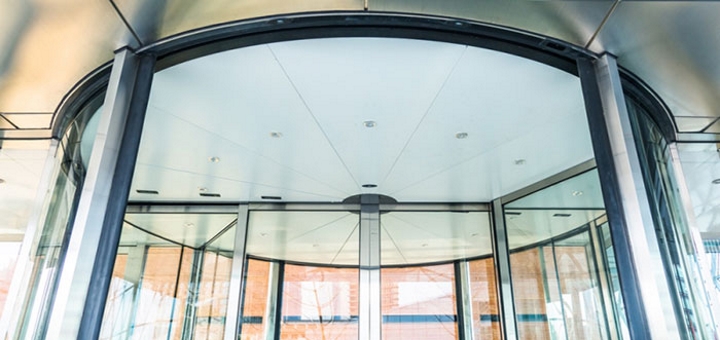The benefits of revolving doors on a commercial property

They’re a familiar sight these days at airports, office buildings, hotels and IKEA stores the world over, but revolving doors have been around a lot longer than you might imagine.
Early “storm doors”
The first patent for a rotating “door without draught of air” can be traced back to a German called Bockhacker in 1881.
However, it was American Theophilus Van Kannel who came up with the concept of three compartments separated by radiating wings – in his 1888 US patent for a “Storm-Door Structure” – and whose idea really caught on.
Van Kannel’s invention was recognised by the Franklin Institute in 1889, and the first wooden revolving door was installed at a Times Square restaurant in 1899.
Environmental and other benefits
More than a century later, the practical benefits that Bockhacker and Van Kannel identified – such as keeping out wind, rain and noise, and saving energy – continue to be the core principles on which modern revolving doors are marketed.
One US study, for instance, found that a revolving door could generate annual savings of 14.6 tons of carbon and $8,500 in heating costs compared to a normal swing door.
As time as gone on, more has also been made of revolving doors’ style – as a design statement, or sometimes incorporating a central display case – as well as their safety and security features.
The access control functionality of revolving doors is particularly important to Dublin-based Advance Access, an Irish company that specialises in solutions such as turnstiles, barriers and entry systems.
Alongside revolving doors being able to be used in combination with other security systems, the wider benefits that inspired the 19th-century inventors remain compelling.
As Advance Access notes, revolving doors:
- Generate energy savings of up to 74% depending on usage, according to a 2006 MIT study, with a consequent reduction in CO2 emissions
- Maintain a desirable building temperature by restricting the amount of hot air entering in the summer, or cold air entering in the winter
- Prevent the “chimney effect” that occurs when air is sucked through open doors and pushed through and out the building
- Improve traffic flow by allowing many people to enter and exit a building at the same time
- Avoid the draughts that occur from swinging doors
- Prevent outside fumes from coming into a building
- Facilitate access for those in wheelchairs, on crutches, or who are entering a building with luggage or other items.
Encouraging use of revolving doors
These benefits are why revolving doors are so widely used by buildings such as shopping centres, hospitals, museums and more.
Nevertheless, the same MIT study that highlighted the impressive potential energy savings also found that many people would prefer to use a swing door if given the two options side by side, citing it as “easier” and less “stressful” than a revolving door.
The MIT research, and a similar later experiment by designer Andrew Shea, found that revolving door use could be greatly increased by displaying signage that highlights the energy-saving benefits of doing so.
The key, perhaps, is to combine this need for education about the green credentials of revolving doors with designing better doors in the first place.
Advance Access, for instance, creates doors that it sees as “beautiful and stylish” as well as practical, and incorporates optional features that improve the user experience, such as larger compartments, full or semi-automatic operation, and LED lighting.
The lesson seems to be that if you create revolving doors that are attractive, safe and user-friendly, everyone wins – it’s good for the environment, and good for those who enter and exit those doors every day.









